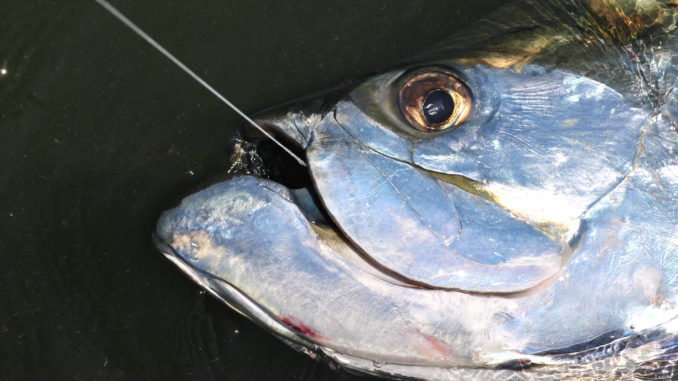
Heavy tackle and a stout back are among requirements for battling with visiting summer silver kings off Hilton Head and Beaufort
As water temperatures surge under the sweltering summer sun, tarpon, aka the world’s greatest saltwater gamefish, migrate northward along the eastern seaboard.
Shortly after crossing the Georgia-South Carolina border, a huge chunk of the migratory fleet turns into the rich waters of the Port Royal, St. Helena and Calibogue sounds to take up summer residence. With the year’s hottest weather arriving, opportunities for connecting with one of these massive silver beasts are far from unusual.
Anglers using the right stuff, in the right way, in the right places — and with a little luck — can surely hook up to one of these powerful creatures in the waters around Beaufort and Hilton Head.
Connecting with one of these beasts fuels one of the fastest growing catch-and-release fisheries in South Carolina waters, and for good reason. Unfortunately, face-to-face encounters can be infrequent, even for the region’s most-seasoned tarpon anglers. But time investments and proper technique can narrow the gap and increase the chances of stretching line with a tarpon on the opposing end.
For centuries, huge schools of adult tarpon have ventured up the eastern coast from their wintering grounds in the Gulf of Mexico. They have been reported to migrate as far north as Nova Scotia, but Virginia, North Carolina, Georgia and South Carolina accommodate the majority of the summering population of tarpon in the western Atlantic. The waters along South Carolina’s salty shoreline have always been inviting for these exquisite fish, with endless opportunities from state line to state line. Yet the Port Royal and Calibogue sounds provide fishermen with a unique situation involving big tides, lots of structure and tons of baitfish.
The summer erupts when the water temperatures become suitable for both tarpon and their forage base. According to Capt. Danny Rourk of Tailwind Charters, tarpon show up just behind the cobia run, when the water temperatures reach the mid 70s.
“As the water temperatures progressively get warmer, the bait comes in,” said Rourk. “Tarpon follow the baitfish migration from down south into our area.”
Tarpon will rarely be too far away from their dinner basket. They will be congregated around big schools of baitfish — usually menhaden along the Carolina coast. But mullet, spots, and croakers are also favored delicacies for these apex predators. As soon as the huge schools of menhaden pile into Port Royal Sound, schools of tarpon will be lurking close by.
Over the summer, anglers catch tarpon in a variety of places, from the beachfront to more than 10 miles up area rivers into brackish water. The same day a tarpon is caught in the ocean in front of one of Hilton Head’s hotels, it would not be unusual for another tarpon to jump on an angler’s bait near the railroad trestle across the Broad River, several miles inland. These fish are very mobile and can be caught anywhere in the region where bait is stacked up.
Generally, the big schools of bait break into somewhat smaller schools and scatter inshore along the main channels and large bays. Consequently, the tarpon divide and conquer, breaking up into smaller groups, going after the large concentrations of bait. So the fish munching in the ocean outside Trenchard’s Inlet are probably not part of the same group found frolicking at Woods Memorial Bridge in Beaufort.
Nevertheless, tarpon will travel throughout the day, following schools of bait from place to place along the main runs. Rourk believes they travel these deep-water runs along ledges, following the bait and stopping along the way at unique places to set up and feed.
“When these fish move, they move down channel breaks, and in the Broad River, it is usually that 30-foot channel ledge,” said Rourk, who requires several key components for a good tarpon spot.
“Find places where the bait is stacked up with deep water and structure. I like any kind of structure, such as the Broad River Bridge or the piles of ballast rocks in the mouth of Port Royal Sound. I also fish places along the main runs that have sandbars that jut out and disrupt the flow. The bait moving down the ledge gets disoriented, which is good news for the tarpon.”
Capt. Christopher Mattson who owns Mattson Charter Services and guides for Spring Island Outfitters Guide, chooses places to anchor along strong runs with high current just as Rourk does. He requires places with a deeper cut, sand bar, or something to divert the strong current for the fish to lay in.
“Generally, tarpon are lazy when they get here and need a big enough dip for the fish to lay out of the heavy current and wait for their meals to come by,” Mattson said.
Choosing the best tarpon spot can be a challenge, but a unique biological characteristic of these fish will let anglers know when it is time to pick up the anchor or stay around for another hour.
Tarpon have the ability to gather oxygen from the air with their functional swim bladder and often require this direct gulping mechanism to function efficiently in brackish water. It is very common for tarpon to surface in the summer to gulp air when they are around.
“When the water heats up, they will let you know where they are,” Mattson said. “It’s also a good time to move when I am not seeing menhaden moving through. The fish will be right with the big schools of bait.”
Mattson will move frequently throughout the day to find where the fish are holding and actively feeding. Tarpon never let their grocery store get too far away.
The lower reaches of South Carolina’s coastline are unique, with tidal swings well over seven feet between the high and low ends. The big tide creates strong currents that can be beneficial for tarpon fishermen. Mattson believes the tides have a positive effect on the way tarpon eat that can increase hook-up rates.
“Because of extreme current, the bite is on bottom. Tarpon don’t have much time to think about eating bait coming by,” he said. “If they are going to eat it, they must eat it quick.”
As with other large gamefish, chumming is a good way to get some blood in the water and activate a feeding frenzy. Mattson and Rourk catch an extra bucket of bait dedicated for chumming — “chunking” as they call it.
“Cut the fish into large pieces so that (they) sink to the bottom,” Rourk said. “(Tarpon) are mostly scavengers and will eat what is easy.”
Due to their availability, menhaden is the primary source for chum, and Mattson believes the chum should always be what makes up the majority of their current forage base. However, Mattson will purposely use a different kind of fish for bait.
“I always fish with something different than what I am chumming with to get more hits,” he said. “They are more likely to eat something tumbling by that is different than what they are constantly seeing.”
Mattson will use mullet, pinfish, ladyfish, croakers or anything else he can get fresh and alive. Rourk also prefers fresh bait and will use the biggest baits he can get.
“Tarpon will eat small baits, but the bigger the better for me,” said Rourk, who will fish four rods: two free-lined and two weighted on the bottom.
DESTINATION INFORMATION
HOW TO GET THERE — The tarpon waters around Beaufort and Hilton Head are accessible from 27 boat ramps in Beaufort County. On the Broad River, the Broad River Landing off SR 170 is most convenient for fishing the Broad River. From Hilton Head, use the Broad Creek Landing on CR 245 off US 278. In Beaufort, us the Freedom Mall Landing on the Beaufort River just south of Beaufort below US 21.
WHEN TO GO — Tarpon begin trickling into the area as early as June and will remain until September or October — or whenever water temperatures begin to drop below 75 degrees. The best fishing will be from July through September when the waters are hot and the bait is abundant.
BAIT/TECHNIQUE/TACKLE — Good, fresh bait is preferred for connecting with tarpon. Live menhaden, mullet and croaker are ideal, but freshly-caught croaker, mullet, menhaden and spot are also fine to use for cut bait and for chumming. Never use old, frozen bait. Only use chum that sinks to bottom, and change baits very frequently. Use 6/0 to 7/0 light-wire Owner circle hooks. Fluorocarbon leaders in 80- to 125-pound test, 10 feet long, are the norm. They can be tied to running line with a surgeon’s, Albright, or nail knot. Use six to eight ounces of lead on bottom lines and no weight on live bait surface lines. Use extreme caution when approaching a school of fish; drifting toward the fish is often the best set-up. Tarpon rarely just nibble. They inhale baits into the back of their mouths just before they swallow it or spit it back out. When a fish bites, leave the rod in the holder long enough for the fish to hook itself. Heavy to medium-heavy action spinning or baitcasting outfits with a high-capacity spool are needed to handle the tarpon’s long runs. A stiff rod is needed to drive the hook into their hard, bony mouths.
FISHING INFO/GUIDES — Capt. Danny Rourk, Tailwind Charters, 843-525-1515 or www.tailwindcharters.com; Capt. Christopher Mattson, Mattson Charters/Spring Island Outfitters Guide, 843-694-7422 or www.springisland.com. See also Guides and Charters in Classifieds.
ACCOMMODATIONS — HiltonHead.com, 843-757-9889 or www.hiltonhead.com; Beaufort Regional Chamber of Commerce and Visitors Center, 800-638-3525 or www.beaufortsc.org; South Carolina Association of Visitors Bureaus (www.discoversouthcarolina.com).
MAPS — Navionics, 800-848-5896 or www.navionics.com; Waterproof Charts, 800-423-9026 or www.waterproofcharts.com, SeaLake Fishing Guides, 800-411-0185 or www.sealakeusa.com.

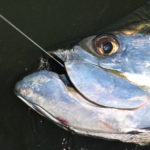
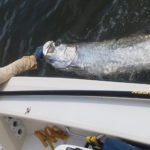
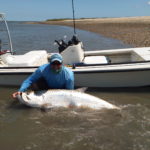
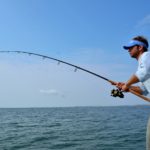
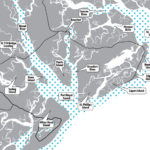




Be the first to comment